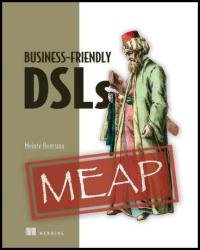Business-Friendly DSLs (MEAP v10)
- Добавил: literator
- Дата: 24-01-2023, 03:58
- Комментариев: 0
 Название: Business-Friendly DSLs (MEAP v10)
Название: Business-Friendly DSLs (MEAP v10)Автор: Meinte Boersma
Издательство: Manning Publications
Год: 2023
Страниц: 653
Язык: английский
Формат: pdf, epub
Размер: 43.6 MB
Written for developers who need to create user-facing Domain-Specific Languages (DSLs), Business-Friendly DSLs unlocks clear and practical methods to create DSLs with easy-to-use interfaces.
Imagine if your non-technical clients could safely produce software without the need for anyone to manually write code. Domain-specific languages are purpose-built programming interfaces that make that possible—no programming experience required.
If you’re reading this book, you’ve probably already heard about DSLs. You might even have realized that you may need to use one. But do you really? And what is a DSL, and how would you build one? The tricky thing with teaching about DSLs is that it’s a very broad topic, with many interconnections to other topics in both software development, and computer science. It’s also a topic that can be -and is- looked at from many different angles. Don’t worry: this book will not try to teach you everything about DSLs, or overwhelm you with unnecessary details. Instead, it’ll take you on a carefully-planned route that walks you through a set of connected topics that cover all the basics and skills that you need to craft your own DSLs. This learning path will be example-driven, quite literally going from the concrete to the abstract.
It will also focus on DSLs for business-purposes, that aim to empower domain experts that are first and foremost business stakeholders—that explains the “business-friendly” part of the title of this book. To that end, we’ll start with sketching out an example business case for which we’ll build a complete DSL throughout the book.
The main reason that software development is like this, is that business experts normally don’t have the background, knowledge, or skills to develop software themselves. Even though they tend to be highly-educated, they typically have had no exposure to, or education in programming. To put it another way: they are probably great at specifying the What, but probably not at specifying the How. Wouldn’t it be great if they didn’t have to learn about all the latest innovations in software development, but could “just” write down their business knowledge using helpful tools?
In this book, we’re going to explore how to develop software tools for the business experts that allow them to write down their business knowledge in a way that’s understandable for them. Moreover, the business knowledge written down that way will be automatically translated into working software, without requiring a software developer for every change. This puts the business experts, rather than the software developers, at the center of software development.
Written for developers who need to create user-facing DSLs, Business-Friendly DSLs unlocks clear and practical methods to create DSLs with easy-to-use interfaces. Author Meinte Boersma lays out an iterative process for creating languages accessible to domain experts such as operations specialists, data analysts, and financial experts. You'll start with an overview of software language engineering before diving into the unique projectional editing paradigm that makes it easy to produce DSLs for business.
Скачать Business-Friendly DSLs (MEAP v10)
Внимание
Уважаемый посетитель, Вы зашли на сайт как незарегистрированный пользователь.
Мы рекомендуем Вам зарегистрироваться либо войти на сайт под своим именем.
Уважаемый посетитель, Вы зашли на сайт как незарегистрированный пользователь.
Мы рекомендуем Вам зарегистрироваться либо войти на сайт под своим именем.
Информация
Посетители, находящиеся в группе Гости, не могут оставлять комментарии к данной публикации.
Посетители, находящиеся в группе Гости, не могут оставлять комментарии к данной публикации.
